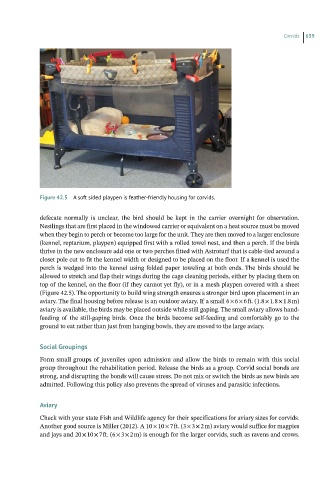Page 658 - Hand rearing birds second
P. 658
Corvids 659
Figure 42.5 A soft sided playpen is feather-friendly housing for corvids.
defecate normally is unclear, the bird should be kept in the carrier overnight for observation.
Nestlings that are first placed in the windowed carrier or equivalent on a heat source must be moved
when they begin to perch or become too large for the unit. They are then moved to a larger enclosure
(kennel, reptarium, playpen) equipped first with a rolled towel nest, and then a perch. If the birds
thrive in the new enclosure add one or two perches fitted with Astroturf that is cable-tied around a
closet pole cut to fit the kennel width or designed to be placed on the floor. If a kennel is used the
perch is wedged into the kennel using folded paper toweling at both ends. The birds should be
allowed to stretch and flap their wings during the cage cleaning periods, either by placing them on
top of the kennel, on the floor (if they cannot yet fly), or in a mesh playpen covered with a sheet
(Figure 42.5). The opportunity to build wing strength ensures a stronger bird upon placement in an
aviary. The final housing before release is an outdoor aviary. If a small 6 × 6 × 6 ft. (1.8 × 1.8 × 1.8 m)
aviary is available, the birds may be placed outside while still gaping. The small aviary allows hand-
feeding of the still-gaping birds. Once the birds become self-feeding and comfortably go to the
ground to eat rather than just from hanging bowls, they are moved to the large aviary.
SocialGroupings
Form small groups of juveniles upon admission and allow the birds to remain with this social
group throughout the rehabilitation period. Release the birds as a group. Corvid social bonds are
strong, and disrupting the bonds will cause stress. Do not mix or switch the birds as new birds are
admitted. Following this policy also prevents the spread of viruses and parasitic infections.
Aviary
Check with your state Fish and Wildlife agency for their specifications for aviary sizes for corvids.
Another good source is Miller (2012). A 10 × 10 × 7 ft. (3 × 3 × 2 m) aviary would suffice for magpies
and jays and 20 × 10 × 7 ft. (6 × 3 × 2 m) is enough for the larger corvids, such as ravens and crows.

